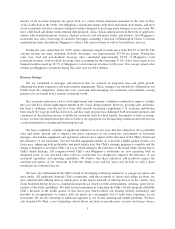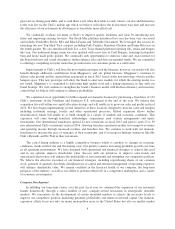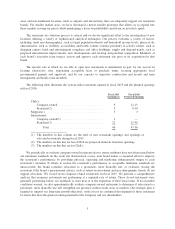Chili's 2015 Annual Report Download - page 19
Download and view the complete annual report
Please find page 19 of the 2015 Chili's annual report below. You can navigate through the pages in the report by either clicking on the pages listed below, or by using the keyword search tool below to find specific information within the annual report.to pay required construction contributions or satisfy other lease covenants to us. In addition, other tenants at retail
centers in which we or our franchisees are located or have executed leases, may fail to open or may cease
operations. If our landlords fail to satisfy required co-tenancies, this may result in us or our franchisees
terminating leases or delaying openings in these locations. Also, decreases in total tenant occupancy in retail
centers in which we are located may affect guest traffic at our restaurants. All of these factors could have a
material adverse impact on our operations.
The success of our franchisees is important to our future growth.
We have a significant percentage of system-wide restaurants owned and operated by our franchisees. While
our franchise agreements are designed to maintain brand consistency, the franchise relationship reduces our
direct day-to-day oversight of these restaurants and may expose us to risks not otherwise encountered if we
maintained ownership and control. These risks include franchisee defaults in their obligations to us arising from
financial or other difficulties encountered by them, such as payments to us or maintenance and improvements
obligations; limitations on enforcement of franchise obligations due to bankruptcy or insolvency proceedings;
inability to participate in business strategy changes due to financial constraints; inability to meet rent obligations
on leases on which we retain contingent liability; and failure to comply with food quality and preparation
requirements subjecting us to litigation even when we are not legally liable for a franchisee’s actions or failure to
act.
Additionally our international franchisees and joint venture partners are subject to risks not encountered by
our domestic franchisees. These risks include:
• difficulties in achieving consistency of product quality and service as compared to U.S. operations;
• changes to recipes and menu offerings to meet cultural norms;
• challenges to obtain adequate and reliable supplies necessary to provide menu items and maintain food
quality; and
• differences, changes or uncertainties in economic, regulatory, legal, cultural, social and political
conditions.
Our sales volumes generally decrease in winter months in North America.
Our sales volumes fluctuate seasonally and are generally higher in the summer months and lower in the
winter months, which may cause seasonal fluctuations in our operating results.
Unfavorable publicity relating to one or more of our restaurants in a particular brand may taint public
perception of the brand.
Multi-unit restaurant businesses can be adversely affected by publicity resulting from poor food quality,
illness or health concerns or operating issues stemming from one or a limited number of restaurants. In particular,
since we depend heavily on the Chili’s brand for a majority of our revenues, unfavorable publicity relating to one
or more Chili’s restaurants could have a material adverse effect on the Chili’s brand, and consequently on our
business, financial condition and results of operations. The speed at which negative publicity (whether or not
accurate) can be disseminated has increased dramatically with the capabilities of electronic communication,
including social media. If we are unable to quickly and effectively respond to such reports, we may suffer
declines in guest traffic which could materially impact our financial performance.
Our inability or failure to recognize, respond to and effectively manage the accelerated impact of social
media could materially adversely impact our business.
There has been a marked increase in the use of social media platforms and similar devices which allow
individuals access to a broad audience of consumers and other interested persons. Many social media platforms
13
























